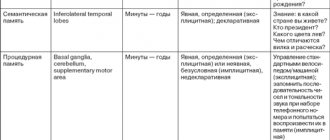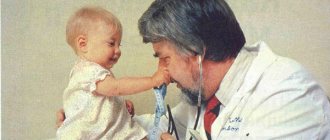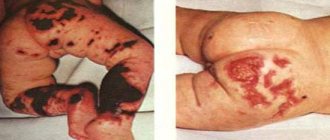Autism - what kind of disease is it? Causes of autism, symptoms and early signs
Autism in children is a special personality disorder, which, although characterized by a violation of social behavior and adaptation to environmental conditions, is not a disease.
The syndrome develops in the first years of a child’s life, when there is an absence or inadequate reaction to auditory or visual stimuli, strange fears, and repetitive behavior. If similar symptoms are observed in a teenager, this diagnosis is doubtful.
The level of intellectual development in this disease can be very different: from profound mental retardation to giftedness in certain areas of knowledge and art; In some cases, children with autism have no speech, and there are deviations in the development of motor skills, attention, perception, emotional and other areas of the psyche. More than 80% of children with autism are disabled.
Causes of autism
Most often, children with RDA are physically absolutely healthy; they do not show any visible external defects. In mothers, pregnancy proceeds without any special features. In sick babies, the structure of the brain is practically no different from the norm. Many even notice the special attractiveness of the facial part of an autistic child.
However, in some cases, other signs of the disease still appear:
- maternal infection with rubella during pregnancy;
- chromosomal abnormalities;
- tuberous sclerosis;
- cerebral palsy;
- violation of fat metabolism - obese women have a high risk of giving birth to a child with congenital autism.
All of the above conditions have a negative impact on the child’s brain and can lead to the development of autism. According to research, genetic predisposition plays a role: if there is an autistic person in the family, the risk of developing the disease increases. However, reliable reasons have not yet been identified.
Symptoms of autism in a child
In some children, symptoms of autism can be detected as early as infancy. Autism most often appears by age three. Signs of autism may vary depending on the child's developmental level and age (see photo).
Behavioral characteristics used to describe autism syndrome:
The development of non-speech and speech communication is impaired. Characteristic:
- Speech is normal, but the child cannot talk with others;
- The speech is abnormal in content and form, that is, the child repeats phrases heard somewhere that do not apply to the given situation;
- Lack of facial expressions and gestures. Speech may also be absent;
- The child never smiles at the interlocutor, does not look him in the eyes;
- Speech is phonetically abnormal (problems with intonation, rhythm, monotony of speech).
The development of imagination is impaired, which leads to a limited range of interests. Characteristic:
- Preference is given to solitude, playing with oneself;
- Lack of imagination and interest in imaginary events;
- gravitates toward a certain object and experiences an obsessive desire to constantly hold it in his hands;
- Unnatural, nervous, aloof behavior;
- An autistic child exhibits tantrums when the environment changes;
- Experiences a requirement to repeat the same actions exactly;
- Concentrates his attention on one thing.
The development of social skills is impaired. Characteristic:
- Ignoring the feelings and existence of other people (even parents);
- They don’t share their problems with loved ones because they don’t see the need for it;
- Children do not want to communicate and make friends with their peers;
- They never imitate the facial expressions or gestures of other people or repeat these actions unconsciously, without connecting them in any way with the situation.
People with autism are characterized by uneven development, which gives them the opportunity to be talented in some narrow area (music, mathematics). Autism is characterized by impaired development of social, thinking, and speech skills.
Autism - symptoms and treatment
Is it possible to recover from autism?
Autism is a disorder that cannot be completely cured, but with timely initiation of complex therapy, it is possible to reduce the severity of its symptoms.
Treatment in children
Speech therapy treatment. During therapy, special attention is paid to correctional and developmental classes with a speech therapist, a speech pathologist and a psychologist. They should be carried out by specialists with experience in interacting with such children, since working with autism has its own specifics: the need to adapt the child to new conditions, involve all analyzers (tactile, auditory, gustatory, visual, olfactory), involve the child in the lesson by motivation, practicing the pointing gesture [13]. A positive result is achieved only with regular classes involving the child’s entire family: parents, brothers and sisters.
Among modern approaches to correctional work, the following can be distinguished:
ABA therapy (applied behavior analysis) is a set of techniques aimed at correcting a child’s behavior and acquiring self-care and social skills. Using a reward system, a child with autism is taught missing everyday and communication skills. Delicious food, praise, and tokens are used as rewards. Each simple action is learned separately, then they are combined into a sequence. For example, at the beginning the child is given a simple task (for example, “raise your hand”), a hint is immediately given (the specialist raises the child’s hand), then the child is encouraged. After several such attempts, the child already performs the action without prompting, expecting a reward. Gradually, tasks become more complicated, given in random order, in different situations, by different people, family members to consolidate the skill. At some point, the child begins to independently understand and complete new tasks.
In the same way, playing skills, constructive activities, and learning are trained, and unwanted behavior is corrected. The effectiveness of applied behavior analysis has been confirmed by scientific research [20]. The earlier you start using the method (preferably from 3-4 years old), the more intense the classes are (at least 20-40 hours a week with a total duration of 1000 hours) and the more actively the method is included in the child’s daily life (its use by parents at home and on a walk, teachers at school, teachers in kindergarten), the more efficiently it will work.
The Denver model is based on ABA therapy methods - an integrated approach for children with ASD from 3 to 5 years old, teaching the child all the necessary skills for this age, which can subsequently significantly increase his adaptive abilities.
PECS (Picture Exchange Communication System) is an alternative communication system using picture cards. The cards depict objects or actions with which a child can turn to an adult to get what he wants. Training in this method is carried out using ABA therapy tactics. Although it does not directly teach spoken language, some children with autism in this program develop spontaneous speech.
TEACH (Treatment and Education for Autistic and related Communication handicapped Children ) is a program based on the idea of structured learning: dividing space into separate zones intended for a specific type of activity (work zones, recreation zone), planning pastimes according to visual schedules, system task presentations, visualization of task structure.
DIR (Developmental Individual differences Relationship-based) is a concept for providing comprehensive assistance to children with various developmental disorders, taking into account individual characteristics and based on building relationships between family members. One of the components of this program is the Floortime technique, which teaches parents to interact and develop an autistic child by including them in their play and gradually involving them in a shared “space.”
The emotional-level approach was developed by domestic psychologists (Lebedinskaya, Nikolskaya, Baenskaya, Liebling) and is widely used in Russia and the CIS countries. It is based on ideas about the levels of emotional regulation in the body that are disrupted in autism. This approach involves therapy through establishing emotional contact with the child. In the future, work is carried out to overcome fears and aggression, and focus is formed in activities.
Sensory integration is a method aimed at organizing sensations received from one’s own movements and the external world (tactile, muscular, vestibular). According to sensory integration theory, when the ability to perceive and process sensations from body movements and external influences is impaired, learning and behavior can be disrupted. Performing certain exercises improves the brain's processing of sensory stimuli, which leads to improved behavior and learning. This type of therapy is not used independently; it can be a supporting method within the framework of ABA therapy.
Drug therapy is usually prescribed during periods of exacerbation of the condition, taking into account the balance of benefit and risk, and is carried out under the supervision of a physician [19]. Drugs can reduce some types of behavioral problems: hyperactivity, tantrums, sleep disorders, anxiety, self-aggression. This can make it easier for the child to participate in family life, visit public places, and go to school. After achieving stable remission, the drug is gradually discontinued. Drug treatment is used in cases where other methods of therapy are not effective.
However, there are symptoms and problems that cannot be controlled with medications:
- failure to follow verbal instructions;
- problematic behavior with the aim of giving up certain activities;
- low learning rate;
- lack of speech and other communication problems;
- low social skills.
If there are concomitant diseases (for example, epilepsy), in addition to a psychiatrist, the child should be monitored by a neurologist and pediatrician.
Treatment for adults
ASD can be corrected in adulthood using cognitive behavioral psychotherapy. Specific treatments are tailored to the problems the person with ASD faces (such as social isolation or relationship problems). You may also be able to take prescription medications to reduce the anxiety and depression that can occur with ASD. Medicines are selected individually by a psychiatrist.
How to live with a child with autism
A child with ASD requires attention and care, so, as a rule, one of the parents has to resign; most often this decision is made by the mother. A clear distribution of roles for family members when caring for a child is important - this directly affects his quality of life. A family in which a child with ASD is growing up faces an important task: it is necessary to create an environment where not only the child with ASD, but also all family members will have development prospects. When a parent receives effective psychological help, this has a positive effect on the condition of the child with ASD, since the parent’s good health helps him better support the child [24].
Can autistic people have healthy children?
The manifestation of the disease depends on a combination of genetic factors and environmental influences, however, the risk of having children with ASD in parents with this disorder is much higher than the average in the population.
According to NIH (National Institutes of Health) research, ASD occurs in approximately 3-5% of children who have an aunt or uncle with the disorder. For comparison, in the general population, ASD is detected in 1.5% of children [27].
Autism in a child over 11 years old
Simple communication skills have been mastered, but the child prefers to spend time in a deserted room. Other signs are also noted:
- interest is directed only to one area, a toy, a cartoon, a program;
- attention deficit;
- aimless complex movements;
- compliance with one’s own, often ridiculous from the outside, rules;
- strange fears also occur;
- hyperactivity;
- the need for a uniform arrangement of furniture and things in the house - if it is moved, the child may have a hysteria or panic attack;
- the child must follow a certain sequence when dressing, waking up, and going to bed;
- self-directed aggression.
Teaching children with autism is difficult, but this does not mean that all autistic people have a low IQ - it is difficult for them to quickly change their activity and focus their attention equally on several objects. Parenting requires enormous effort on the part of parents: after all, if a child has learned to go to the potty or change clothes at home, this does not mean that he will be able to do this at a party or in kindergarten.
Why are the number of children with autism increasing?
Autism has long been considered a rare disorder, but since the early 1990s the number of cases began to increase sharply, and in many countries there was talk of an autism epidemic. It is believed that this is due to improvements in the diagnosis of autism and more frequent use of this term as a diagnosis.
The most detailed statistics on autism are kept in the USA, in California. In March 1999, state officials were surprised and concerned about the threefold (210%) increase in autism between 1987 and 1998 and created a special commission to study the problem. The panel concluded that these dynamics could not be explained by changes in diagnostic criteria, the assumption that large numbers of children with autism had moved to California, or some statistical anomaly (Sicile-Kira, 2010).
The data is really scary (www.tacanow.org; www.cdc.gov):
- 1992: 1 case per 10,000 children;
- 1997: 1 in 500;
- 2002: 1 in 250;
- 2012: 1 in 88.
In Russia, there are no official statistics on the number of children with autism. “But even in its absence, based on indirect data, we can say with confidence that today the number of autistic children aged 2 to 16 years exceeds 300 thousand people” (1st Moscow International Conference on Autism, 2013).
A genetic predisposition to autism is recognized; Thus, some of its traits may be present in a weaker form in parents, brothers, sisters and other close relatives. If there is a child with autism in a family, there is a chance (15–20%) that another child will develop it; If one identical twin has autism, 90% of the time the other will have it too. It is known that autism is four times more common in boys than in girls.
There are many different theories, there is no consensus, but in general the cause of autism is considered to be a complex interaction of genetic factors, the consequences of pathology of pregnancy and childbirth, traumatic brain injuries, and adverse effects of the external environment.
Pollution of water and air with toxic substances seems to be one of the most likely factors. In addition, in the last 20 years, which has seen a sharp increase in the number of cases of autism, we live surrounded by a mass of various devices that emit electromagnetic waves. You can’t hide from them - and it’s difficult to assume that their constant impact on our body is safe.
Symptoms of the disease between the ages of 2 and 11 years
Children with autism at this age still experience symptoms that were relevant for the previous period. The child does not respond to his own name, does not look him in the eye, likes to be alone, and has no interest in other children. In addition, other characteristic symptoms of the disease are noted:
- Perhaps, again, repetition of the same type of actions (peculiar rituals), when changing his usual environment, he becomes very anxious.
- The child knows only a few words and may not speak at all.
- The child may constantly repeat the same word; he does not maintain a conversation.
- For the most part, children with autism struggle to acquire skills that are new to them; at school age they lack the ability to read or write.
Some children develop an interest in a certain type of activity, for example, mathematics, music, drawing, etc.
How does autism manifest?
The disease manifests itself in the appearance of characteristic symptoms that can be detected already in the second year of the baby’s life.
Isolation from others
Parents may suspect a mild disorder of the nervous system if the child does not respond to an adult’s speech, always looks away, and does not look at the person who is addressing him. The child may laugh for no apparent reason or, conversely, will not even smile at any attempt by an adult to make him laugh.
Tries to communicate only with gestures, and does this only if there is a need to indicate to an adult his desires or needs.
He is not at all interested in communicating with his peers, and he is also unable to find contact with other kids, so he prefers to spend time alone. Such a child loves to play alone, and if another child tries to join him, he will most likely throw a tantrum or be capricious.
An additional difference between an autistic child is the lack of ability to play any role-playing games. He cannot come up with a plot for the game, and he perceives any toy completely differently, for weeks healthy children. For example, a child may be interested only in a specific part of a toy; he may spend hours looking at a wheel from a car and will not even think that this item can be used in another way, for example, rolled on the floor.
Even though a child with autism is unable to express emotions, he will still become anxious if his mother is out of sight.
Communication breakdown
Absolute absence of speech or delay in full development of speech are disorders that often occur in the youngest patients. The development of speech skills in such children depends on the severity of the disease. If a severe form of the pathology has been advanced, then the child may not begin to talk at all in the future. In some cases, patients learn to express their wishes and requests in short words. More often, speech is still present in such patients, but incoherent sentences are more like just a collection of random words.
Autistic children often have no reaction when called by name. They always talk about themselves in the third person. Their speech often does not make sense, and when asked a question, they can answer something that has nothing to do with you in the conversation.
Stereotypical behavior
This type of behavior includes:
- Daily rituals. Autistic children love to be in a familiar and comfortable environment. If any changes occur in their usual way of life, for example, rearranging furniture or moving, then they experience discomfort and anxiety. This can make a child withdraw into himself or cause him to become aggressive.
- Obsession, which manifests itself in concentrating on one activity. It is sometimes difficult to distract a child with autism from an activity to which he is willing to devote several hours.
- Intense fear. If a child often experiences stress, he may develop aggression not only towards others, but also towards himself.
- Repeated repetition of certain movements. If an autistic child finds himself in an unfamiliar environment or experiences stress, he begins to repeat the same movement over and over: swaying from side to side, fiddling with his fingers, or shaking his head.
Early symptoms of the disease
Parents may notice telltale signs of early autism in their child before he or she turns one. Children with this nervous system disease are inactive and show little or no interest in toys. Against the background of normal physical development, such children do not show a desire to learn new subjects.
Signs of early childhood autism under 2 years of age
In most cases, manifestations of the disease are observed in children during the first year of their life. There may be characteristic differences in the behavior of a sick child from the behavior of peers. The following symptoms are also noted:
- The child rarely smiles;
- There is no attachment to the mother. So, the child does not cry like other children when she goes somewhere, he does not smile at her and does not reach out for her arms;
- A child with autism does not look at the parents’ face, into their eyes;
- The child may have an inadequate response to stimuli that are insignificant for others (light, muffled sounds, etc.), in addition, he may experience fear because of them.
- The child is noted to be aggressive towards other children, he does not strive to communicate with them and to play together;
- A sick child gives preference to only one toy (or a separate part of it) in play; there is no interest in other toys;
- There is a delay in speech development. So, by 12 months the child does not babble, does not use the simplest words by the age of 16 months, and by the age of 24 months does not reproduce simple phrases.
Meanwhile, it is important to note that such symptoms are not at all exclusive indicators of the relevance of autism, although they require some concern. Therefore, the child’s avoidance of society, his silence, self-absorption - all these manifestations must be discussed with the pediatrician.
What is autism?
Autism is a disease of the nervous system that is diagnosed in most cases in early childhood. The disease manifests itself in children as a reluctance to make contact with anyone, repeated actions of the child and developmental delays. Boys suffer from autism more often than girls; about 2% of children on the planet suffer from this disease. In adulthood, autism practically does not manifest itself if there were no signs of it in childhood.
At the same time, in recent years there have been more and more patients, but whether this is due to the spread of the disease or to improved diagnosis is not yet clear. The term “autism” is translated as “in oneself,” which emphasizes the child’s focus on his inner world and a sharp reaction to the interference of the outside world.
IQ level in autism
Most children with autism have mild or moderate mental retardation. It is associated with brain defects and learning difficulties. If the disease is combined with microcephaly, epilepsy and chromosomal abnormalities, then the level of intelligence corresponds to severe mental retardation. With mild forms of the disease and dynamic development of speech, intelligence can be normal or even above average.
The main feature of autism is selective intelligence. That is, children can be strong in mathematics, music, and drawing, but at the same time be far behind their peers in other respects. The phenomenon when an autistic person is extremely gifted in some area is called savantism. Savants can play a melody after hearing it just once. Or paint a picture seen once, accurate to halftones. Or keep columns of numbers in your head, performing complex computational operations without additional means.
Severity
There are several degrees of severity, which make it even more clear what autism is:
| 1st degree | Children can communicate, but in unusual surroundings they are easily lost. Movements are awkward and slow; the child does not gesture, his speech is amicable. Sometimes such children are diagnosed with mental retardation. |
| 2nd degree | Children do not appear withdrawn or aloof. They talk a lot, but do not address anyone. They especially love to talk about their area of interest, which they have studied thoroughly. |
| 3rd degree | In a familiar environment, the child behaves normally, but when visiting new places he has an attack of panic or self-injury. Such a patient confuses pronouns and answers with useless cliches. |
| 4th degree | Children do not respond to treatment, do not make eye contact, and practically do not speak. If they are comfortable, they sit for hours, looking ahead, discomfort manifests itself in screaming and crying. |
Socialization problems
Children, even very young ones, gradually socialize in society. Eye contact, reaction to sounds, to mother's or father's voice, touches and smiles - this is something that is typical for a baby at his age. If the child feels detached, contact with parents is disrupted at such a young age, when the child simply needs such manifestations of care and communication, this is an alarming sign.
Very young children often use gestures in order to get something, but in the case of a sick child, everything happens the same way, but at the same time he does not seek to capture the attention of the parent. It is believed that an autistic child, due to impairments, cannot perceive a picture as a whole; he sees a person or a toy as if separately, like a set of body parts or details. He does not understand the emotions of other people, and his emotions cannot be understood: for example, he may laugh for no reason, or, conversely, not react when his parents make him laugh.
By the age of 2, children begin to look for peers, actively get to know and play with them, a child with autism syndrome does not show such interest, he is comfortable within himself and he perceives any attempts to get to know him as an annoying intrusion into his territory, he may not pay his attention on others or perceive them as inanimate objects.
If the game does start, it is difficult for the child to adapt, he cannot play roles, as often happens in childhood, he is much more comfortable focusing on the details of a toy, for example, combing a doll or spinning a car wheel. It is important to remember that this is not a one-time action, but repeated over and over again.
Such children do not react to the emotions of their parents, do not show their attachment to them in any way, at one time it was even believed that in relation to autistic people there is no such attachment at all. It has now been proven that this is not the case, the child simply does not show his attitude to what is happening; if he is left in kindergarten, he will not grab his mother’s hands and ask her not to leave, but will feel the same anxiety as and a healthy child.
Diagnosis of autism
External clinical signs of autism in a child of the first year of life are practically absent, and only experienced parents with more than 1 child in the family manage to notice any developmental abnormalities with which they consult a doctor.
If there are already cases of autism in the family or lineage, then it is extremely important to carefully monitor the child and promptly seek medical help if necessary. The sooner a child is diagnosed, the easier it will be for him to adapt to the world and society around him.
The main methods for diagnosing autism in children are:
- examination of the child by an otolaryngologist and a hearing test - this is necessary to exclude delayed speech development due to hearing loss;
- EEG – carried out to detect epilepsy, since sometimes autism can manifest itself as epileptic seizures;
- Ultrasound of the brain - allows you to identify or exclude damage and abnormalities in the structure of the brain that can provoke symptoms of the disease;
- conducting tests with special questionnaires.
Parents themselves must correctly assess changes in the behavior of a child who may have autism.
Psychological state and lifestyle of the mother
The lifestyle of the child's mother and her psychological state during pregnancy can also affect the development of such a disease.
Past illnesses
One of the causes of autism is considered to be infectious diseases suffered by a pregnant woman during pregnancy. These infections include measles, herpes and chickenpox. Even ordinary flu and acute viral infections during this period almost double the risk of having an autistic child.
Prenatal stress
The emotional state of a woman during pregnancy can also be the cause of autistic cycle disorders in the child. Frequent stress suffered by a woman during such a period increases the concentration of glucocorticoids in the blood, which, if in excess, are not neutralized, but enter the fetus’s body. Hormones are able to penetrate the child’s brain, causing various disorders in it that appear immediately after the birth of the baby or as it develops. This is usually the period of the first year of life, or seven to nine years. Glucocorticoids, circulating throughout the child’s body, cause increased anxiety, severe fears, contribute to the development of nervous system disorders, as well as psychosomatic diseases, including early childhood autism.
Bad habits
Bad habits that the mother has during pregnancy play an important role in the development of childhood autism. Smoking is especially harmful. Although scientists have not yet openly stated the connection between autism in children and smoking by the expectant mother, the results of research conducted in this area indicate that it exists. Thus, smoking by a pregnant woman can trigger the development of specific forms of autism in the child.
Alcohol, caffeine, medications and drugs used by the expectant mother also do not bring anything good for the baby’s health. Although a direct connection between their use and the development of autism in children has not been established, such bad habits generally have a bad effect on the health of the fetus and cause pathological processes in its body.
Parents' age
In this matter, the age of the father is of great importance. Men over the age of fifty have a sixty-six percent increased risk of autism. If at the time of conception the age of the future father was from forty to fifty years, then the figure dropped to twenty-eight percent.
The late age of the mother also leaves its mark. Women who become mothers after the age of forty are fifteen percent more likely to have an autistic child than those aged thirty. And if both parents crossed the age of forty, the risks increased even more.
Best materials of the month
- Coronaviruses: SARS-CoV-2 (COVID-19)
- Antibiotics for the prevention and treatment of COVID-19: how effective are they?
- The most common "office" diseases
- Does vodka kill coronavirus?
- How to stay alive on our roads?
It should be noted that the large age difference between parents plays a role. Children most susceptible to autism are those whose fathers are between the ages of thirty-five and forty, and whose mothers are ten years older. Conversely, if a man is ten years younger than a woman, and she, in turn, is between thirty and forty years old, the risk of developing the disease is also quite high.
Set of factors
It is necessary to talk about any one reason for the occurrence of pathology with caution. Recently, scientists have increasingly noted the fact that the emergence and development of autism spectrum disorders is influenced by a combination of various factors, including hereditary predisposition, ecology, the age of parents and various psychological reasons.
Treatment of autism
The answer to the main question: is autism treatable? -No. There is no cure for this disease. There is no pill that, after drinking, will help an autistic child come out of his “shell” and become socialized. The only way to adapt an autistic person to life in society is through persistent daily practice and the creation of a favorable environment. This is a lot of work by parents and teachers, which almost always bears fruit.
Principles of raising an autistic child:
- Create a favorable environment for the child’s life, development and learning. A frightening environment and an unstable daily routine slow down an autistic person’s skills and force them to “withdraw” even deeper.
- Understand that autism is a way of being. A child with this condition sees, hears, thinks and feels differently from most people.
- Involve a psychologist, psychiatrist, speech therapist and other specialists in working with the child if necessary.
At the present stage, help for sick children can only be provided by a correctional program drawn up by a competent specialist - a sequence of actions that are carried out not to cure autism (it cannot be treated), but with the goal of maximizing the child’s adaptation to environmental conditions.
To implement this program, the help of parents is very important, because for the baby the whole world is incomprehensible and hostile.
Correction is carried out in special rehabilitation centers (for example, Our Sunny World or Childhood). The correction program depends on the form and severity of the disease. It includes:
- drug treatment;
- gluten-free diet;
- hippotherapy;
- behavioral therapy;
- music therapy;
- play therapy;
- exercise therapy;
- dolphin therapy;
- massage.
Classes of different types of therapy can be conducted in different centers. Thus, hippotherapy is usually carried out in a specially equipped arena, music treatment is carried out in special rooms. Physical therapy and massage are usually carried out in the same clinic.
What to do?
Yes, autism is a child development disorder that lasts throughout life. But thanks to timely diagnosis and early correctional assistance, much can be achieved: adapt the child to life in society; teach him to cope with his own fears; control emotions.
- The most important thing is not to disguise the diagnosis as supposedly “more harmonious” and “socially acceptable.” Do not run away from the problem and do not focus all your attention on the negative aspects of the diagnosis, such as disability, misunderstanding of others, conflicts in the family, etc. An exaggerated idea of a child as a genius is just as harmful as a depressed state from his failure.
- It is necessary without hesitation to abandon tormenting illusions and plans for life built in advance. Accept the child for who he really is. Act based on the child’s interests, creating an atmosphere of love and goodwill around him, organizing his world until he learns to do it on his own.
Remember that a child with autism cannot survive without your support.
Modern ideas about autism
Autism was long considered a psychiatric disease until the work of Bernard Rimland (1964) and Carl Delacato (Delacato, 1974) appeared in the early second half of the twentieth century.
Bernard Rimland, professor of psychology, founder of the Autism Society of America, and father of a child with autism, believed that the problem with a child with autism is that he is unable to correctly interpret incoming sensory signals.
Carl Delacato also believed that many manifestations of autism are caused by disturbances in the functioning of sensory functions and that, therefore, autism is not a psychological or mental disorder, but a neurological disorder that must be addressed by neurological rehabilitation methods. He showed that severe behavioral problems in children with autism can be caused by sensory processing disorders and proposed methods for addressing these problems, many of which were developed during his many years of work at IAHP, the Institutes for Achieving Human Potential, founded by Glenn Doman. The book by Carl Delacato (Delacato, 1974) undeservedly remains little known, despite the fact that it contains information that anyone dealing with autism, especially specialists, needs to know.
Teaching an autistic child
An autistic child, as a rule, cannot study in a regular school. More often, homeschooling is done by parents or a visiting specialist. Special schools have been opened in large cities. Training there is carried out using special methods.
The most common training programs:
- “Time on the floor”: the technique suggests treatment and teaching communication skills to be carried out in a playful way (a parent or teacher plays with the child on the floor for several hours).
- “Applied Behavior Analysis”: step-by-step training under the guidance of a psychologist from simple skills to the formation of spoken language.
- The “More Than Words” program method teaches parents to understand the nonverbal way of communicating with a child using gestures, facial expressions, his gaze, etc. The psychologist (or parents) help the child develop new methods for communicating with other people that are more understandable to them.
- Card exchange teaching method: used for severe autism and when the child has no speech. During the learning process, the child is helped to remember the meaning of various cards and use them for communication. This allows the child to take initiative and facilitates communication.
- “Social stories” are original fairy tales written by teachers or parents. They should describe situations that cause the child’s fears and anxiety, and the thoughts and emotions of the characters in the stories suggest the child’s desired behavior in such a situation.
- The TEASSN program: the methodology recommends an individual approach to each child, taking into account his characteristics and learning goals. This technique can be combined with other teaching technologies.
A strict daily routine, constant and not always successful activities with a child suffering from autism leave an imprint on the life of the entire family. Such conditions require extraordinary patience and tolerance from family members. But only love and patience will help you achieve even the slightest progress.
Prognosis for autism
The number of British studies talking about qualitative changes and devoted to long-term prognosis is small. Some autistic people experience minor improvements in their communication skills as adults, but for many more these skills worsen.
The prognosis for the development of autism is as follows: 10% of adult patients have several friends and require some support; 19% have a relative degree of independence, but remain at home and require daily supervision, as well as significant support; 46% require specialist care for autism spectrum disorders; and 12% of patients require highly organized hospital care.
Swedish data from 2005 in a group of 78 autistic adults showed even worse results. Of the total, only 4% lived an independent life. Since the 1990s, as well as the early 2000s, the increase in reports of new cases of autism has increased significantly. Since 2011-2012, autism spectrum disorder has been observed in every 50th schoolchild in the United States, as well as in every 38th schoolchild in South Korea.
Types of Autism
Today it is customary to distinguish two types of autism:
Type 1 – classic, the child is sick from birth. It follows that the cause of autism is genetic. It was previously called Kanner's autism.
Type 2 – acquired or regressive. A child is born with completely normal development, but from 1 to 2 years of age regression occurs. This may be directly related to the weakening of the immune system and the production of a large number of antibodies.
Today, type 1 autism is rare: 1 case per 10,000. The second type, regressive autism and autism spectrum disorders, is 40 times more common than the first, and its frequency is increasing every year.










